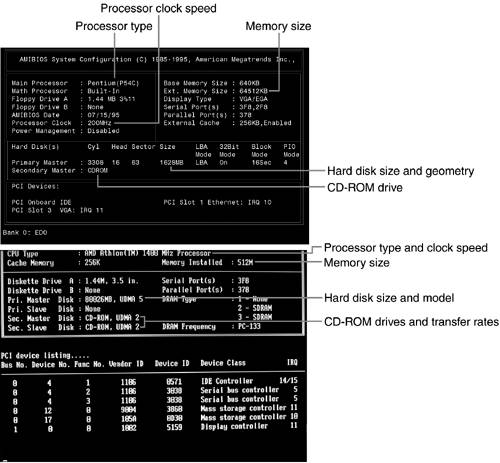| Got a recent system? Any system built in the last three years can easily achieve (and usually far surpass) the hardware requirements for installing any version of Windows covered on the A+ Certification Operating Systems Exam. However, in the real world, digital dinosaurs that might not be fast enough or have enough free disk space to support some versions of Windows still roam the earth. Table 16.1 lists the requirements for Windows 95, 98, and Me, and Table 16.2 lists the requirements for Windows NT 4.0 Workstation, Windows 2000 Professional, and Windows XP. Table 16.1. Hardware Requirements for Windows 9x/Me by Version | Hardware Component | Windows Version | | | 95 | 98 | Me | | Processor | 386DX | 486-DX2 66MHz | Pentium 150MHz | | RAM | 4MB | 16MB, 24MB [1] | 32MB | | Free disk space | 50MB to 55MB | 225MB (typical) [2] | 320MB | | Floppy drive | 1.44MB, 3.5-inch | 1.44MB, 3.5-inch | 1.44MB, 3.5-inch | | CD-ROM drive [3] | Optional | Optional | Required | | Display | VGA [5] | VGA [6] | VGA [6] | | Microsoft mouse or compatible | Optional | Optional | Required | | Multimedia [4] | Optional | Optional | Required | [1] Windows 98 Second Edition requires 24MB of RAM [2] Can vary between 165MB and 295MB depending upon options and computer configuration [3] DVD- ROM , CD -RW, and DVD-rewritable can be substituted [5] 256- color recommended [6] 16-bit or higher color depth at 800 x 600 or higher resolutions recommended [4] Sound card, speakers , or headphones Table 16.2. Hardware Requirements for Windows NT 4.0/2000/XP by Version | Hardware Component | Windows Version | | | NT 4.0 Workstation | 2000 Professional | XP Home/Pro | | Processor | Pentium [1] | Pentium 133MHz | Pentium 233MHz | | RAM | 16MB | 64MB | 64MB | | Free disk space | 110MB | 650MB [2] | 1.5GB | | Floppy drive | Optional | 1.44MB, 3.5-inch | Optional | | CD-ROM drive [3] | Required | Optional | Required | | Display | VGA | VGA | Super VGA [4] | | Microsoft mouse or compatible | Required | Required | Required | | Multimedia [5] | Optional | Optional | Required | | Keyboard | Required | Required | Required | [1] Intel version; Alpha AXP, MIPS R4x00, and Power PC processors also supported by separate versions [2] 2GB or larger hard disk also required [3] DVD- ROM , CD -RW, DVD-rewritable can be substituted [4] 800 x 600 resolution [5] Sound card, speakers, or headphones Did you notice how the processor, RAM, and free disk space requirements keep climbing with each new Windows version? All the bells , whistles, and stability of Windows XP have a cost in faster hardware. Thus, before you even consider an upgrade to an older system, you'd better check its stats against what you see in Tables 16.1 and 16.2. tip  | You might like to recycle old computer parts , but if the processor, hard disk size, and memory size of your PC barely meet the Microsoft requirements, prepare to be annoyed at how slowly your computer runs and how limited its capabilities are. You're much better off if your system greatly exceeds the minimums listed in Tables 16.1 and 16.2. |
You know what Microsoft is expecting from your hardware. How can you get the gory details about your system? You can use methods discussed in Chapter 2, "PC Anatomy 101," to check your system's hardware against these hardware requirements. For example, Figure 16.1 shows the startup system configuration displayed by a 200MHz Pentium system (top) and a 1.4GHz Athlon system (bottom). Although the Pentium-based system is obsolete by any measure, its clock speed (200MHz), memory size (64MB), and hard disk size (1.6GB) are sufficient to support Windows 9x/Me and Windows NT/2000 ( assuming adequate free disk space). However, the 1.4GHz Athlon system comfortably exceeds all requirements for any current version of Windows. Figure 16.1. An elderly Pentium-class system (top) is still powerful enough to run older versions of Windows, but a 1.4GHz Athlon system (bottom) exceeds the requirements for all versions of Windows including XP by a wide margin.  caution  | Note that the installation programs for Windows 2000/Me/XP all test the system for compliance with minimum processor and memory requirements and will not install on systems that don't meet the minimum standards. You can sometimes use optional switches with the setup program to bypass verification, but running these versions of Windows with hardware that doesn't meet the minimum standards is not recommended. In plain English, don't even try it! |
|
